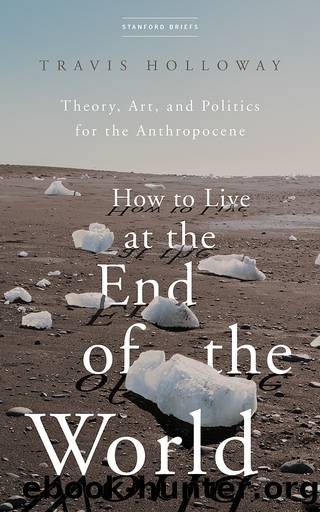How to Live at the End of the World by Travis Holloway

Author:Travis Holloway
Language: eng
Format: epub
Publisher: Stanford University Press
Published: 2022-06-15T00:00:00+00:00
Wynter cites from Pico della Mirandolaâs Oration on the Dignity of Man in the opening of her essay on colonialism and humanism, and discusses Picoâs philosophy throughout the essay. Picoâs Oration on the Dignity of Man was composed in 1486 in Italyâsix years before the initial voyage of Columbusâand is seen as one of the more celebrated writings on the Renaissance philosophy of man. In this work, Pico exemplifies a certain Renaissance vision of human exceptionalism, rank, and individualism as he declares that nothing is âmore wonderful than manâ and investigates manâs ârankâ in the âuniversal chain of Beingââa rank that he says is âenvied not only by brutes but even by the stars.â46 Commentators describe Picoâs Oration as a tribute to human beings and an attempt to answer âwhat really constitutes the superiority of man over other beings.â47 The passage from Picoâs Oration that Wynter focuses on narrates how God assigned âmanâ âa place in the middle of the world,â âat the worldâs centerâ; Pico adds that â[t]he nature of all other beings is limited and constrained within the bounds of laws prescribed by Us.â48
The locus of racism and colonialism here is not so much that Pico looks down upon other cultures and traditions in the Oration.49 It is rather that, systematically and narratively, Picoâs ontological hierarchy and its cartography offer an underlying system of veridiction for levels or tiers of existence among human beings, nonhumans, and the earth. Specifically, Pico introduces a hierarchy of beings, a concept of (a certain) man as superior, a notion of this man being at the âcenter,â and, more specifically, a center that is written about from the point of view of Europe and theorized from out of oneâs own interior self.50 Even more importantly for Wynter, this âmanâ must engage in a âspiritual warâ that divides the world between friends and enemies, good and evil, spirit and flesh, gods and beasts, an interior and a periphery.51
For Wynter, Picoâs text exemplifies the theoretical foundation for colonialism, racism, and a certain anthropocentrism. Wynter argues that narratives like Picoâs permitted Europeans to determine who was human and who was inhuman; to arm themselves with the force of law behind them; to ground themselves in Europe and their own subjectivity; and, ultimately, to enslave others and reduce nature to themselves. Pico, for example, explains that brutes, animals, plants, and matter are beneath humans in order and dignity. Furthermore, the figure of man in the Oration is endowed with a special ability to make laws that limit and constrain âall other beings,â which forms the narrative basis for the modern state. This hierarchy of beings situates European âmanâ and his way of life at the center of the world, and as having mastery over all other beings and the earth.
Still, where did Picoâs humanism begin? Pico says explicitly that he has âarranged the fruit of [his] thinking on . . . Platonic and Aristotelian philosophy.â52 This includes a certain hierarchy of beings (see Aristotle, History of Animals)
Download
This site does not store any files on its server. We only index and link to content provided by other sites. Please contact the content providers to delete copyright contents if any and email us, we'll remove relevant links or contents immediately.
The remains of the day by Kazuo Ishiguro(8817)
Tools of Titans by Timothy Ferriss(8213)
Giovanni's Room by James Baldwin(7188)
The Black Swan by Nassim Nicholas Taleb(7010)
Inner Engineering: A Yogi's Guide to Joy by Sadhguru(6722)
The Way of Zen by Alan W. Watts(6504)
Asking the Right Questions: A Guide to Critical Thinking by M. Neil Browne & Stuart M. Keeley(5631)
The Power of Now: A Guide to Spiritual Enlightenment by Eckhart Tolle(5604)
The Six Wives Of Henry VIII (WOMEN IN HISTORY) by Fraser Antonia(5394)
Astrophysics for People in a Hurry by Neil DeGrasse Tyson(5130)
Housekeeping by Marilynne Robinson(4335)
12 Rules for Life by Jordan B. Peterson(4249)
Double Down (Diary of a Wimpy Kid Book 11) by Jeff Kinney(4204)
The Ethical Slut by Janet W. Hardy(4172)
Skin in the Game by Nassim Nicholas Taleb(4161)
Ikigai by Héctor García & Francesc Miralles(4123)
The Art of Happiness by The Dalai Lama(4063)
Skin in the Game: Hidden Asymmetries in Daily Life by Nassim Nicholas Taleb(3929)
Walking by Henry David Thoreau(3892)
